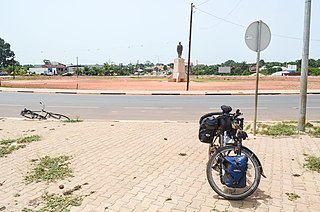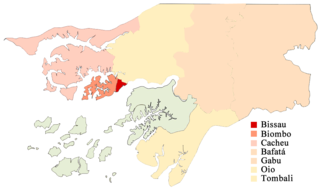

This is a list of cities in Guinea-Bissau order by population. All settlements with a population of over 5,000 are included.


This is a list of cities in Guinea-Bissau order by population. All settlements with a population of over 5,000 are included.
| Cities in Guinea-Bissau | |||||
|---|---|---|---|---|---|
| Rank | City | Population (2009 Census) [1] | Region | ||
| 1 | Bissau | 387,909 | Bissau | ||
| 2 | Gabú | 43,556 | Gabú | ||
| 3 | Bafatá | 29,556 | Bafatá | ||
| 4 | Canchungo | 12,044 | Cacheu | ||
| 5 | Bissorã | 9,898 | Oio | ||
| 6 | Farim | 9,005 | Oio | ||
| 7 | Mansôa | 8,313 | Oio | ||
| 8 | Buba | 7,898 | Quinara | ||
| 9 | Cacheu | 5,891 | Cacheu | ||
| 10 | Quinhámel | 5,825 | Biombo | ||
| 11 | Quebo | 5,454 | Quinara | ||
| 12 | Catió | 5,081 | Tombali | ||
| 13 | Bolama | 5,026 | Bolama | ||

Guinea-Bissau, officially the Republic of Guinea-Bissau, is a country in West Africa that covers 36,125 square kilometres (13,948 sq mi) with an estimated population of 1,726,000. It borders Senegal to the north and Guinea to the south-east.

The economy of Guinea-Bissau comprises a mixture of state-owned and private companies. Guinea-Bissau is among the world's least developed nations and one of the 10 poorest countries in the world, and depends mainly on agriculture and fishing. Cashew crops have increased remarkably in recent years, and the country ranked ninth in cashew production for the year of 2019.
Telecommunications in Guinea-Bissau include radio, television, fixed and mobile telephones, and the Internet.

Bissau is the capital, and largest city of Guinea-Bissau. As of 2015, Bissau had a population of 492,004. Bissau is located on the Geba River estuary, off the Atlantic Ocean, and is Guinea-Bissau's largest city, major port, and its administrative and military centre.
The music of Guinea-Bissau is most widely associated with the polyrhythmic genre of gumbe, the country's primary musical export. Tina and tinga are other popular genres.

Portuguese Guinea, called the Overseas Province of Guinea from 1951 until 1972 and then State of Guinea from 1972 until 1974, was a West African colony of Portugal from 1588 until 10 September 1974, when it gained independence as Guinea-Bissau.

João Bernardo "Nino" Vieira was a Bissau-Guinean politician who was the President of Guinea-Bissau from 1980 to 1999, except for a three-day period in May 1984, and from 2005 to 2009.

The Guinea-Bissau War of Independence, or the Bissau-Guinean War of Independence, was an armed independence conflict that took place in Portuguese Guinea from 1963 to 1974. It was fought between Portugal and the African Party for the Independence of Guinea and Cape Verde, an armed independence movement backed by Cuba, the Soviet Union, and Yugoslavia. The war is commonly referred to as "Portugal's Vietnam" because it was a protracted guerrilla war which had extremely high costs in men and materiel and which created significant internal political turmoil in Portugal.

Safim is a city and sector in the Biombo Region of Guinea-Bissau. It has a population of 17,356 inhabitants as of the 2009 national census.

The following outline is provided as an overview of and topical guide to Guinea-Bissau:
Religion in Guinea-Bissau is diverse, with no particular religion comprising an absolute majority of the population. Islam is the most widely professed faith, and significant populations of Christians and adherents of Traditional Faiths are also present in the country.

Christians in Guinea-Bissau constitute approximately 10 percent (~153,300) of the country's population. Other sources report the population of Christians in Guinea-Bissau may vary from 5 to 13%.

The official language of Guinea-Bissau is Portuguese, which is spoken by 11% of the population. The local dialect is called Crioulo or Kiriol. French is also learned in schools, as Guinea-Bissau is surrounded by French-speaking countries and is a full member of the Francophonie as well as the Lusophone CPLP.
The WHO's estimate of life expectancy for a female child born in Guinea-Bissau in 2008 was 49 years, and 47 years for a boy. in 2016 life expectancy had improved to 58 for men and 61 for women.
Prostitution in Guinea-Bissau is common and there are no prostitution laws. In 2016 it was estimated there were 3,138 prostitutes in the country. Often it is associated with other crimes: Many pimps are also reported to be drug dealers. Poverty leads many women to be tempted into prostitution and cocaine addiction.

Ahmadiyya is an Islamic community in Guinea-Bissau, under the leadership of the caliph in London. First established in the country in 1995, during the era of the Fourth Caliphate, the Community represents an estimated 2% of the country's Muslim population, corresponding to approximately 13,000 people.
The following is a timeline of the history of the city of Bissau, Guinea-Bissau.
Suzi Carla Barbosa is a Bissau-Guinean politician, member of parliament and coordinator of the Committee of Women Parliamentarians of Guinea-Bissau.

The 1980 Guinea-Bissau coup d'état was the bloodless military coup that took place in Guinea-Bissau on 14 November 1980, led by Prime Minister General João Bernardo Vieira. It led to the deposition of President Luís Cabral, who held the office since 1973, while the country's War of Independence was still ongoing.

The COVID-19 pandemic in Guinea-Bissau is part of the worldwide pandemic of coronavirus disease 2019 caused by severe acute respiratory syndrome coronavirus 2. The virus was confirmed to have reached Guinea-Bissau in March 2020.